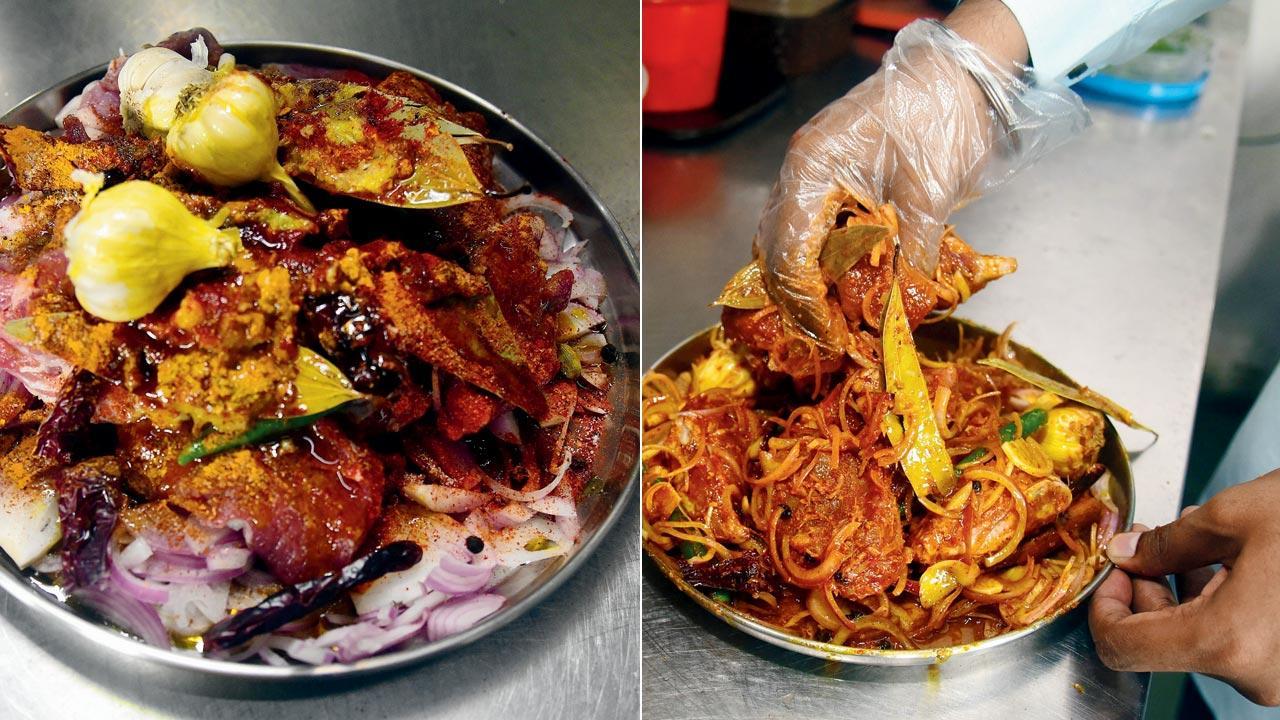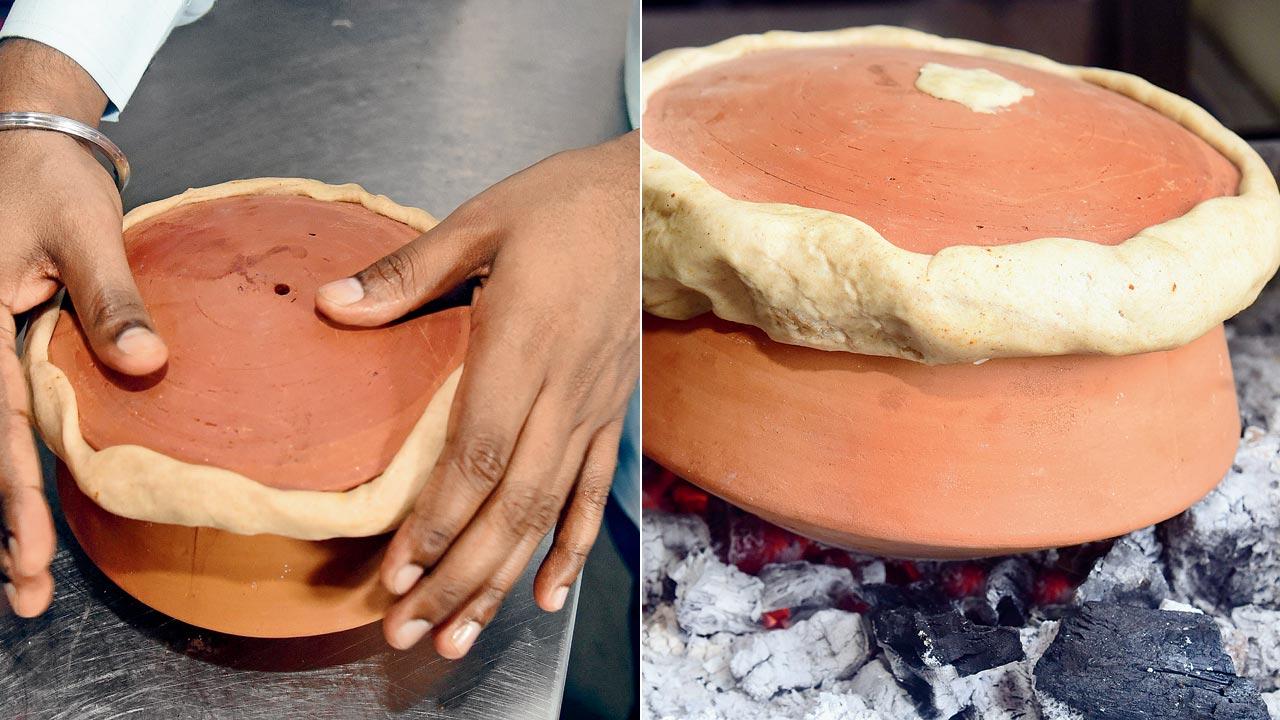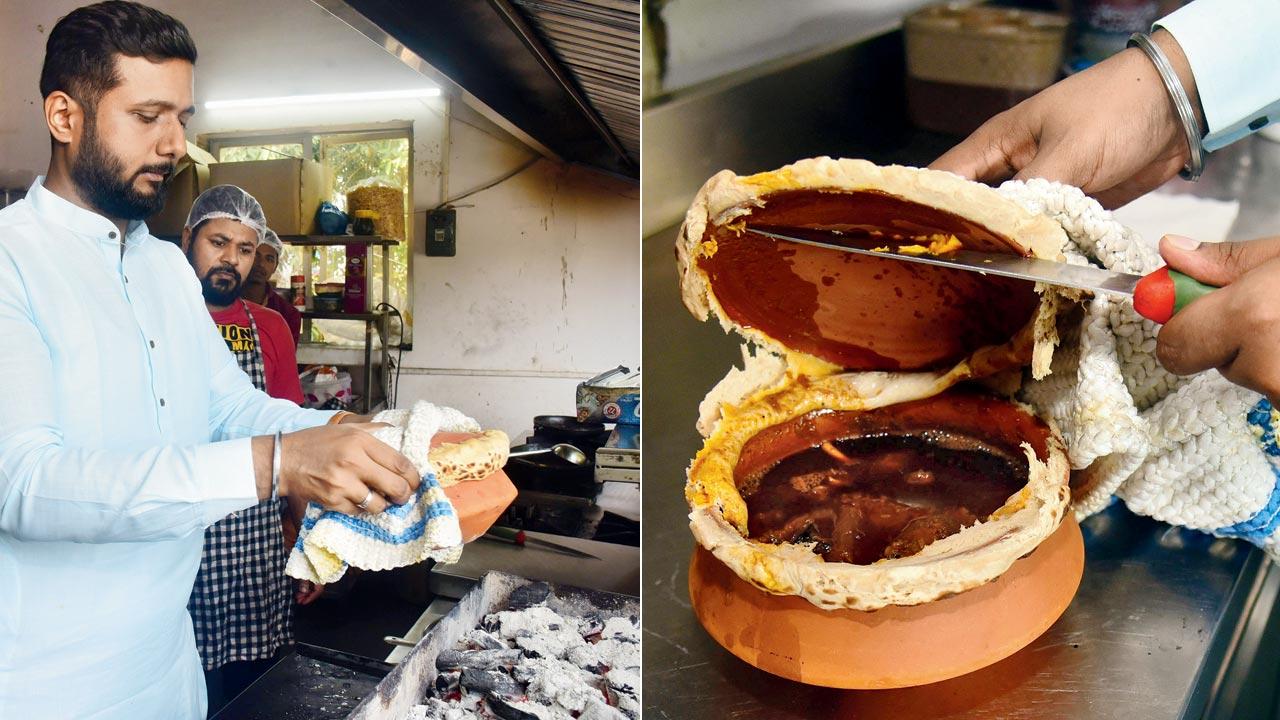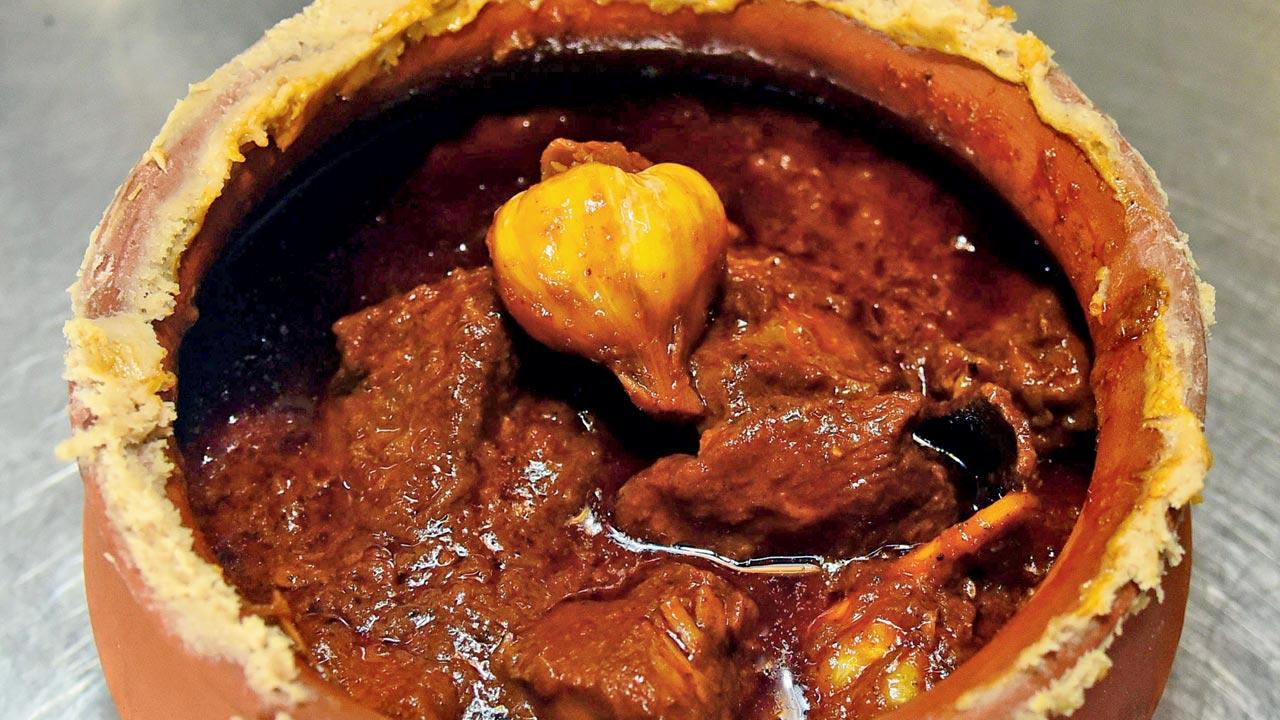Moving beyond litti chokha, the state’s cuisine is spurring curiosity with earthy dishes such as Champaran mutton or Ahuna mutton

The meat marinade includes a garlic pod, sliced onions and whole spices; (right) It is mixed with mustard oil and given a thorough mix. Pics/Shadab Khan
There is no such thing as Champaran mutton,” a friend from Patna tells us, when we ask if they have tried the dish. This curiosity around the Bihari dish that has been recently garnering attention on restaurant menus (in New York too), is validated when we dig into a pop-up menu by Delhi’s Comorin at Jolie’s in Worli. Chef Manish Mehrotra, who hails from Patna, grins. “I never grew up eating Champaran mutton, but we have a way of prepping the meat that has earned its current name from the Bihar region,” he explains, adding, “Most chefs from Bihar are from Motihari region in Champaran and they cook the meat in closed clay pots.”
ADVERTISEMENT
A celebration in Bihar calls for a mutton preparation. In the interiors, it begins by prepping the empty clay handi or ahuna and placing it on a coal fire for a few minutes to make it non-porous and leak-proof.
 The mixture is transferred into a clay pot
The mixture is transferred into a clay pot
The chefs at Saundha, a four-month-old cloud kitchen in Goregaon run by Gaurav Verma and Divya Johry follow the same process for Champaran mutton, their star dish on a menu that promotes traditional slow-cooking on coal.
While the clay pot sits on hot coal, Verma readies the marinade on a plate—sliced onions, whole spices including bay leaf, cinnamon, pepper, elaichi and red chillies. The ground spice mix is similar to Bengali panch phoran, but unique in its ratio. A dollop of ginger garlic paste, which will make the base of the curry and a sprinkle of red chilli powder and turmeric to determine the brown tinge of the final dish. A whole garlic pod will soften in the heat and gain a mushy, sweet taste, losing its potency. To this, he adds, the meat pieces of the raan (leg) and a generous pour of mustard oil that has been smoked before to release the raw bitterness. “The raan cut or leg of the goat retains its shape and texture and doesn’t turn into a mush in the pot. It cooks into a juicy bite and the bones release a robust flavour,” Verma promises, giving the ingredients a gentle mix.
 The claypot is air-sealed with a dough strip; (right) It is put on a coal fire and takes about two hours to cook through
The claypot is air-sealed with a dough strip; (right) It is put on a coal fire and takes about two hours to cook through
“Saundha,” Johry explains, “means smokiness, which is imparted to food through slow cooking on wood or coal fire. Once the coals are fired, you cannot control it or speed it up.”
Verma takes the clay pot off the heat and fills it up with the marinade. “In a slow cooking process, you have to create a pressure, which comes from sealing the pot,” he says, folding a dough strip around the lining of the lid. He then puts it on the coal to cook. At regular intervals, the pot is given a shake to ensure the ingredients at the bottom of the pot are not overcooked.
 The hot handi is given a shake at regular intervals so that the ingredients at the bottom of the pot don’t overcook; (right) Once cooked, it is opened and served
The hot handi is given a shake at regular intervals so that the ingredients at the bottom of the pot don’t overcook; (right) Once cooked, it is opened and served
While the coal works its magic on the ahuna, Verma lists the core ingredients of Bihari cuisine. “Mustard oil and sattu [mixed protein-rich flour prepared by grinding chana and other cereals], a superfood that offers protein and fibre and has cooling effects on the body. Our staple includes all types of saag, and river fish, including rohu and katla. The dry preparation of mutton is called tash, made by bhujna [frying] and has a Nepali influence, while the jhol [gravy] leans towards the Bengali style [of cooking] with one key difference of absence of sugar. As the food legend goes, Motihari town in the Champaran district cooked its mutton in sealed clay pots on coal or cow dung. The art of dum cooking trickled down from the Mughals,” says Verma.
We try the mutton with a litti (wheat balls) stuffed with sattu freshly prepared for the day. The mutton falls off the bone and the semi-wet curry has a sweet hint of charcoal and an intense hit of spice without being overly fiery. We break the litti (wheat balls) stuffed with sattu and dunk it into the curry with a piece of meat. It reflects the rustic taste of patient cooking on the humble wood fire.

In Hyderabad’s HITEC City, the newly-opened The Pink Elephant also features Champaran mutton on the menu. Chef Mrigank Singh—he used to run Ghosht Stories, a traditional mutton kitchen in Mumbai in the lockdown—gets his meat masala from Bihar. “To make sure we are using the right ratios of the masala, I source it from a local chef. We then reproduce the dish using the traditional ahuna,” says Singh, who has traversed the country to document traditional meat recipes over the years. His version is refined, with a finer, velvety gravy but retaining the authentic flavours.
 Gaurav Verma and Divya Johry
Gaurav Verma and Divya Johry
Dolly Singh, a documentary filmmaker and varied content designer, who used to host a Bihari food pop-up, says, “Champaran mutton is all about how you cook the meat. We put all the ingredients into a clay pot and let it slow-cook. Now if Champaran mutton is a regional delicacy or a social media fad, we can’t tell; this is just how we cook our meat across the state.” She credits Gangs of Wasseypur (2012) for promoting Bihari culture. “Overall, there has been an influx of Bihar and its surroundings in genres of entertainment. Today, we are seeing OTT series and songs inspired by Bihar becoming popular. The culture is bring continuously revisited across formats, so obviously, the cuisine also gets its due. Culinary events, pop-ups and special menus are helping raise awareness,” says Singh. Food, she opines, is a function of geography. “In Bihar, we have the Ganges, its tributaries and the Basin offering the most fertile soil, which determines the seasonal produce. Litti served with chokha [crushed veggies like aubergine, tomatoes or potatoes mixed with red chillies, mustard oil and seasoned with salt] is the first dish that comes to mind, but Bihari cuisine is a lot more than that. Our food is rustic, with strong flavours and unpolished, raw textures. For instance, the Nimona peas curry, or besan ki sabzi made of chana dal. We use a lot of chana, which is also used to make sattu, consumed as a drink, in curries and as a stuffing for littis and parathas,” she explains, highlighting the kathal dum. “It is our vegan answer to mock meat,” she says.
 Mrigank Singh and Dolly Singh
Mrigank Singh and Dolly Singh
Bhujia is usually made with just aloo or aloo mixed with veggies such as gobi, bhindi or parwal. They are fried into crispy bhujia in mustard oil and savoured with dal and rice. “One comfort dish that has become popular from my childhood is dal pitthi—arhar dal with dough folded into various shapes.”
Putting this regional cuisine on the global map will take time. Currently, chefs are showcasing a single dish or choosing specific ingredients to work with. Pop-ups cater to a niche audience that’s curious about novel favours, but a journey of popularity for the cuisine has begun,” Singh concludes.
 Subscribe today by clicking the link and stay updated with the latest news!" Click here!
Subscribe today by clicking the link and stay updated with the latest news!" Click here!







